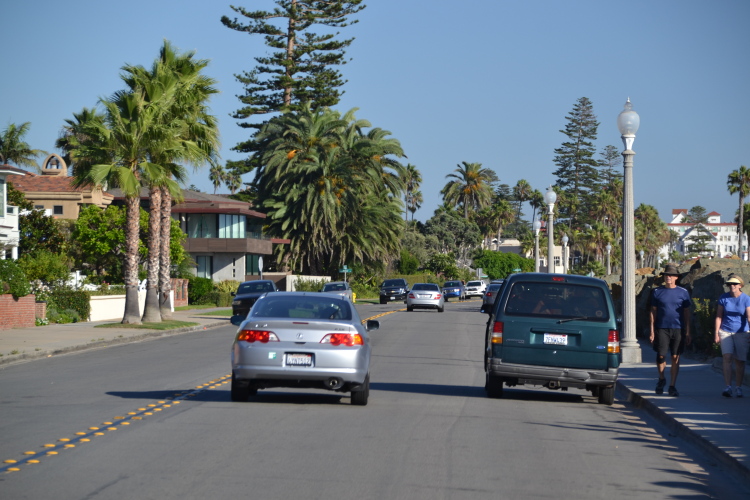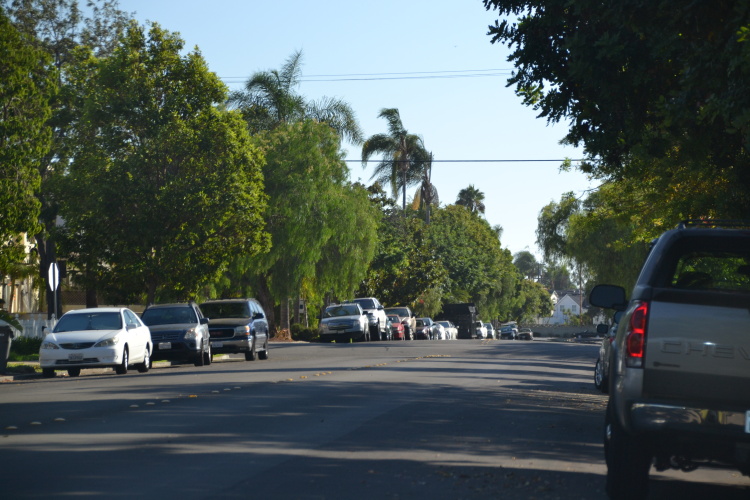
Cartoon taken from age-of-the-sage.org, Transmitting the Wisdoms of the Ages.
At its September 15 meeting the City Council reversed its previous decision to include bike lane and route markings in the already awarded contract to slurry seal Coronado streets. This was the final nail in the coffin of the Citys ill-fated Bicycle Master Plan. Despite its decision to abandon the existing plan, the City will soon begin work on a $180,000 Coronado Comprehensive Active Transportation Strategy. The strategy will include a pedestrian master plan, an updated bicycle master plan, updated Safe Routes to School, and traffic calming recommendations.
Before peoples memories fade, it is worthwhile to review the missteps that punctuated the history of the defunct Bicycle Master plan, particularly in light of the Citys commitment to develop a successor to it.
Over six years ago, in May 2009, the City Council authorized the City staff to apply for a grant from the San Diego Association of Governments (SANDAG) to create a bicycle master plan. A $75,000 grant was received and accepted by the City Council. To assist in developing the scope of work for a consultant to develop the master plan, the City Council appointed a nine member Ad Hoc Bicycle Committee in August 2009. Meetings of the committee were advertised and open to the public. A contract to prepare the plan was awarded to the firm KTU+A in February 2010.
The plan took 13 months to prepare. Two public workshops were held during its preparation, in May and November 2010, to obtain public input. The purpose of the first workshop was to find out what the residents wanted in the plan and the second was to present what was being proposed in the plan. The draft plan was presented to the board of Coronado MainStreet. The plan was also presented to the Parks and Recreation Commission at a publicly advertised meeting.
What, if anything, did the City Councils Adoption of the Bicycle Master Plan Mean?
The plan was completed, and it was adopted by the City Council at its March 15, 2011 meeting. Despite a unanimous vote by the City Council to adopt the Bicycle Master Plan, the minutes of the meeting indicate that the extent of support for the plan was ambiguous. Mayor Casey Tanaka stated that the plan, is a planning document and the City Council is not necessarily approving everything in it. Each item will be brought back at a later date. Councilwoman Barbara Denny stated that she didnt know what worries Mayor Tanaka about the report. She went on to day, She is very happy with it. Councilmember Mike Woiwode was the most clear in his support for the plan. He stated, The routes chosen are there for a good reason and would withstand discussion Ocean Boulevard is an example. It has to be included in whatever is done because people are going to ride on Ocean Boulevard. Councilmember Al Ovrom commented that at least three of the streets in the plan are major thoroughfares and bicycles could cause potential conflicts with auto traffic. Although she is credited with making the motion to adopt the plan, along with Councilmember Ovrom, the minutes indicate that Councilmember Carrie Downey had no comments on the plan.
The motion also tasked the City staff to develop recommendations for the City Council concerning a committee or working group to advise the Council and staff on bicycle-related issues. Based on the staffs recommendation the City Council created the Bicycle Advisory Committee (BAC) on August 16, 2011. In the resolution that was unanimously adopted by the City Council it states that the BAC is charged with annually evaluating and reporting the Citys progress in implementing the Bicycle Master Plan.
The Bicycle Master Plan was subsequently incorporated into the Circulation Element of the Citys General Plan on July 17, 2012. The amendment to the General Plan states, On March 15, 2011, the City Council adopted a Bicycle Master Plan for the City of Coronado. This document establishes the types of bikeway facilities that should be implemented within the City and identifies opportunities to integrate with the existing regional bikeway system in the San Diego metropolitan area. It goes on to include a diagram of the bicycle routes described in the master plan.
Although the City Council voted unanimously to amend the General Plan to include the Bicycle Master Plan, the minutes of the July 17 meeting indicate continued confusion regarding the Councils support for the plan. Councilmember Ovrom is recorded as stating, He doesnt think that we have vetted these possible bike paths to the point where we need to say these are what are being planned within the General Plan. Mayor Tanaka added that he, agrees that the City has not vetted all of these routes but the City Council has accepted the Bicycle Master Plan. He assumes that these routes are part of that plan and he thinks it is a good thing that it says proposed and that the way it is worded it states exactly what it is. These are ideas that we are going to look to vet. Councilmember Downey added that she agreed with the mayor, that the City is a long way away from getting all these facilities at the level we want them to be but this is a step in the right direction.
Given the City Councils apparent lack of commitment to the specific bike paths, lanes, and routes included in the master plan, it is unclear what purpose was served by amending the General Plan to include it and whether its inclusion in the General Plan was appropriate given this lack of commitment. The Citys website states that a jurisdictions General Plan is its Constitution and that it, is an expression of what a community wants. It is a statement of goals, a listing of objectives, and a vision of what might be
The Complaints of Residents Kill Safe Routes to School
Noting opposition to the marking of a bike lane on H Avenue (pictured above) by 17 residents Councilmember Barbara Denny joined other members of the City Council in killing the project after seeking and receiving a grant for marking the bike lane.
Although the City Council was clearly uncertain about its support for the specific projects included in the master plan and had strongly indicated that the projects required further vetting, it sought and received two grants to implement portions of the plan.
The first grant from the Safe Routes to School Program in the amount of $34,900 was accepted by the City Council in August 2012. (Also included was $4,000 in matching funds from Coronado.) The original scope, which was consistent with the master plan, was to install Class 2 bike lanes on Sixth Street from Glorietta Boulevard to Alameda Boulevard and on H Avenue. High Activated Walk (HAWK) signals were originally included in the application at the intersections of H Avenue and Third and Fourth Streets. However, Caltrans would not support the grant application if HAWK signals were included. The City was given the opportunity, which it took, to resubmit the application without the signals.
Despite the fact that the project had the support of the of the Coronado school district, that the marking of bike lanes on Sixth Street and H Avenue was consistent with the master plan, that a grant had been sought and received by the City to perform the work, and that the City staff had prepared the RFP and was ready to bid the project, at its June 18, 2013 meeting the City Council removed the markings on H Avenue from the scope of work because of the opposition to them expressed by some residents of H Avenue.
The minutes of the meeting indicate the continued lack of conviction by the City Council regarding the master plan. Mayor Tanaka expressed his lack of support for a bike lane on H Avenue by stating the thought that councils are very concerned about putting anything like a bike lane where it would seem that the people living next to that lane dont want it. Councilman Bailey added that he thought that the biggest downside to this is that it would give children a false sense of security when riding bikes to school. He would like Safe Routes to Schools pulled from at least H Avenue. Councilmember Denny noted her support for the BAC but there were 17 phone calls, emails and speakers in opposition to the bike lane on H Avenue and therefore she could not support it. Only Councilmember Woiwode was supportive stating that he saw no downside to the proposed lane markings.
The Councils decision to remove the markings on H Avenue from the project required the City staff to prepare and resubmit a revised grant application, the grant administrators to reconsider the application, and the City staff to revise the RFP to eliminate the markings on H Avenue.
From Scenic Loop to Do-Loop
Although the “scenic loop” was the centerpiece of the Bicycle Master Plan support for it by the City Council quickly evaporated because of opposition by the residents of Coronado Avenue, pictured above.
The second grant was for the scenic loop, which was the centerpiece of the Bicycle Master Plan. It included a Class 2 bike lane on Glorietta Boulevard, Class 3 bike routes on Ocean Boulevard and Coronado Avenue, class 2 bike lanes on Sixth Street between Coronado Avenue and Alameda Boulevard, and a class 2 bike lane on Alameda Boulevard from Sixth Street to First Street
In February 2013 the City Council authorized the City Manager to accept a grant of $172,000 from the State Bicycle Transportation Account to construct the loop. The City was obligated to provide $19,200 in matching funds. The City Council approved advertising for the project in May 2013. In July 2013 residents along the proposed scenic loop were provided with a letter that described the proposed loop including a map. The letter also and notified them that a public workshop on the subject was planned for July 31, 2013.
At its August 20, 2013 meeting the City Council directed the staff to reduce the scope of work to include only the marking of the Class 2 bike path on Glorietta Boulevard, the installation of a crosswalk and a rapid flashing beacon at the intersection of Glorietta Boulevard and Fifth Street, and the installation of some new bike lane signs on First Street. The decision to reduce substantially the scope of work required City staff to revise the projects scope of work and to resubmit the grant application before the contract for the project could be awarded.
The meeting minutes showed the superficiality of the Councils support for the bike lanes and routes included in the scenic loop even after having approved advertising for a contract to implement the loop in May. The Council quickly abandoned the loop in response to complaints from a small number of residents of Coronado Avenue that shared-lane markings on the pavement and advertising the existence of a scenic bike loop around Coronado would increase the volume of cyclists to the extent that it would endanger children at play and make it more difficult to back out of driveways.
The Bicycle Master Plans Last Gasp
In February 2015 the City Council directed the staff to consider adding bicycle markings on the roads that would be slurry sealed as part of the Citys annual street maintenance project. To obtain resident input over 1,300 letters were sent to the residents of the streets that would be affected. The notifications were customized to describe the proposed markings for each residents street. The letters also notified each recipient that the marking of the streets would be considered at the City Councils April 21, 2015 meeting. Additional efforts to obtain resident input included the creation of an on-line survey, which allowed residents to provide their input electronically. The survey remained open for approximately a month. Advertisements were placed in the Coronado Eagle/Journal and distributed via the internet.
At its April 21 meeting the City Council authorized the City staff to advertise the slurry seal contract including the installation of bicycle-related pavement markings included in the Bicycle Master Plan on Tenth Street and Alameda Boulevard as well as shared-lane markings on I Avenue, J Avenue, Fifth Street, Second Street between Alameda Boulevard and Orange Avenue, and on Orange Avenue between First and Third Streets. The contract was also to include the installation of a buffered Class 2 bike lane on Olive Avenue and the conversion of the existing head-in diagonal parking to back-in diagonal parking.
The City Council approved award of the slurry contract including the bike markings at its July 21, 2015 meeting. At its September 15, 2015 meeting, subsequent to the award of the slurry contract, the City Council reversed itself and instructed the City staff to remove the bike pavement markings from the contract. The removal of work from a contract rarely, if ever, results in recovery of the full amount included in the original bid for the work. The amount that will be recovered by eliminating the bike markings has not yet been negotiated with the contractor. The negotiations will be complicated by the fact that the bid contained a lump sum for all of the striping including replacement of the existing lane and other markings.
In summary, after six years the City has completed only a small portion of the Bicycle Master Plan after spending $75,000 and many staff and volunteer hours on its preparation. Further, what little has been accomplished has been noteworthy because of the inefficiencies that have wasted City and grant funds and staff time and has, undoubtedly, cost the City credibility with the sources of the grants that it received for work included in the master plan.
Plans for a Comprehensive Active Transportation Strategy for Coronado
Fresh off its experience with the Bicycle Master Plan, the City is about to embark on an even more ambitious effort to develop a Coronado Comprehensive Active Transportation Strategy. Among the goals of the strategy are to encourage and promote the use of active transportation modes, which are defined as forms of human powered transport including walking and cycling, as viable, safe, and convenient travel options in Coronado. The strategy is also intended to reduce traffic speeds via traffic calming measures. The final strategy will include project recommendations for pedestrian, bicycle, traffic calming, and Safe Routes to School improvements. These may include Class 2 bike lanes and Class 3 bike routes, raised and enhanced crosswalks with flashing beacons, bulbouts, and pedestrian refuges at crossings on particularly wide streets.
The application for the grant identified several conditions that support the need for a comprehensive active transportation strategy including the high rate of bicycle and pedestrian collisions in Coronado. Statistics from the California Office of Traffic Safety show that in 2011, the most recent year for which data is available, Coronado ranked number 1 in bicycle collisions and number 15 in pedestrian collisions of 107 similar cities in California.
 The application for the grant to prepare a Coronado Comprehensive Active Transportation Strategy notes that the heavy volume of bicyclists and pedestrians on Ocean Boulevard, along with the vehicular traffic make it a candidate for inclusion in the strategy.
The application for the grant to prepare a Coronado Comprehensive Active Transportation Strategy notes that the heavy volume of bicyclists and pedestrians on Ocean Boulevard, along with the vehicular traffic make it a candidate for inclusion in the strategy.
Additional justification for a comprehensive strategy cited in the application includes the absence of bicycle facilities, such as shared-lane markings, on Orange Avenue. It also noted that bicyclists and pedestrians are required to play frogger when they try to cross Third and Fourth Streets, which are the locations of many accidents. The heavy volume of bicyclists and pedestrians on Ocean Boulevard was described as well as the fact that the road has very narrow sidewalks and no bicycle facilities, making it challenging for bicyclists, pedestrians, and vehicles to share the road. The need for safe routes to school infrastructure near Coronados schools was also stated.
The scope of work for the strategys development includes robust public involvement. Stakeholder interviews will be conducted and a Stakeholder Advisory Committee composed of representatives from a cross-section of the community will be formed. Potential participants include the Coronado Unified School District, Chamber of Commerce, Navy Base Coronado, and neighborhood groups. The committee will meet regularly throughout the strategys development to provide feedback on proposed projects. In addition three public workshops are planned as well as two on-line surveys to ensure that residents have the opportunity to provide their input. The public workshops will be held at key project milestones: needs assessment, project identification, and presentation of the draft strategy.
Preparation of the strategy will be funded by a $90,000 grant and $90,000 funded by the City. A consultant will be hired to prepare the strategy.
The Future: Success or Another Failure?
The question is whether a Comprehensive Active Transportation Strategy will meet with any more success than the now defunct Bicycle Master Plan. Will the City Council learn from the past or is the following quotation by Niccolo Machiavelli the likely predictor of the future of a comprehensive active transportation strategy for Coronado.
Whoever wishes to foresee the future must consult the past; for human events ever resemble those of preceding times. This arises from the fact that they are produced by men who ever have been, and ever shall be, animated by the same passions, and thus they necessarily have the same results.
If you would like to express your opinion and thoughts about how well or poorly the City Council handled the development and implementation of the Bicycle Master Plan and the preparation of a Comprehensive Active Transportation Strategy please complete the survey at https://www.surveymonkey.com/r/3T5WPLZ.
John Tato
Staff Writer






